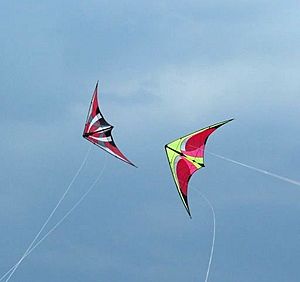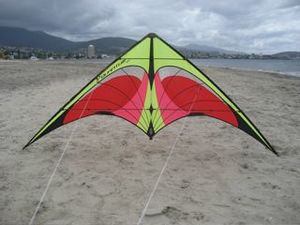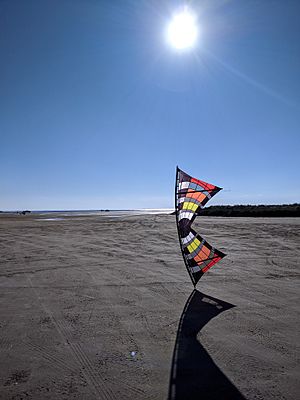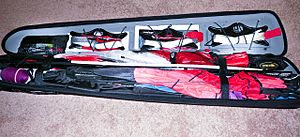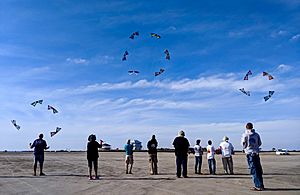Sport kite facts for kids
A sport kite, also called a stunt kite, is a special kite you can steer in the air. It's different from a Power kite, which is much stronger and used to pull people or vehicles. Sport kites are all about doing cool tricks and flying with precision.
Contents
How Sport Kites Are Made
Most sport kites have a triangle-like "delta" shape. They use two lines for you to control them. Some have a "W" shape and use four lines.
These kites are made from light, strong materials. The fabric is usually a special kind of nylon or polyester called ripstop. This fabric is tough and won't tear easily. The frame of the kite is made from carbon fiber tubes. These tubes are light but very strong. The lines you hold are made from a super strong material called ultra-high-molecular-weight polyethylene. This material doesn't stretch and stays slippery, even if the lines get tangled.
Controlling Two-Line Kites
With a two-line sport kite, you control it by pulling or releasing tension on the lines.
- Pull the right line to turn right.
- Pull the left line to turn left.
- Pull both lines equally to fly straight.
- You can also walk forward or backward to change how the kite flies up or down.
By combining these moves, you can do amazing tricks. These tricks range from simple turns and loops to complex flips and spins. When diving, sport kites can fly very fast, up to 100 kilometers per hour (60 mph)! They can also almost stop in the air, which lets you do other cool moves.
Controlling Four-Line Kites
Four-line kites use two handles, each with two lines attached. You control the kite by pulling on different lines. This lets you tilt, spin, or twist the kite in any direction.
Skilled pilots can make four-line kites do things two-line kites can't. They can fly backward, spin in place, hover, and even fly sideways.
Types of Sport Kites
There are three main kinds of sport kites:
Traditional Sport Kites
These kites were popular in the 1990s and early 2000s. They were built for flying with great accuracy. They were often quite large and pulled strongly. Today, these are seen as "old school." Newer kites are more agile and can do more tricks.
Trick Kites
Trick kites became popular after 2000. They are designed to do amazing 3D acrobatic moves. These kites let flyers link many tricks together in a freestyle way.
Quad-Line Kites
Four-line kites first appeared in 1988. They became very popular after a team called The Flying Squad formed in 1999. This team won many championships.
Four-line kites are special because they can hover in the air, unlike other sport kites. They can be flown with extreme precision. They can fly in any direction, including sideways and backward. They can even land exactly on one wingtip.
Kite Technology
Sport kites are designed to fly in different wind conditions. Most standard kites fly best in winds from 1.5 to 6 meters per second (3 to 13 mph).
- "Ultralight" kites are made for very light breezes or even flying indoors.
- "High wind" kites are built for stronger winds, up to about 20 meters per second (45 mph).
It takes practice to fly a kite well in different winds. A steady breeze, without trees or buildings blocking it, is best for smooth flying.
Professional kites use many high-tech materials:
- The kite's fabric is usually special ripstop polyester. It's treated to not stretch, repel water, and block UV rays.
- The edges are often reinforced with strong materials like Dacron or Kevlar.
- The frames are made from carbon fiber tubes. These are light and stiff, but can bend to handle strong winds and crashes.
- The flying lines are made from ultra-high-molecular-weight polyethylene. This material has very little stretch and stays slippery.
Sport kites can cost anywhere from $50 for a beginner kite to over $400 for professional ones. The flying lines are usually sold separately and can cost $50 to over $100 per set.
Some kites are also called power kites. These are used to pull things, like kite buggies or surfboards for kiteboarding. Many strong-pulling kites have a safety strap. You can use this strap in emergencies to release or reduce the kite's power.
Kite Accessories
Many sport kite flyers have different sets of lines. These lines come in various lengths and strengths to match the wind. Special kite bags are made to carry many kites, lines, and repair tools. These tools include tape for fixing tears and spare parts. Some bags are even designed to fit in airplane overhead compartments.
Other cool accessories include small digital anemometers. These tell you the exact wind speed. You can also get LED lights to attach to your kite. This lets you fly it at night!
Kite Competitions
Kite flying has become a real sport. Kite competitions are a lot like figure skating. Judges score flyers on how well they perform set moves and a "ballet" routine. The ballet involves flying to music.
You can compete alone, with a partner, or as a team. Team flying is often the most exciting. Four or more pilots fly very close together, doing amazing formations and tricks.
Competitions are held all over the world by groups like Sport Team and Competitive Kiting (STACK). There's a World Championship every two years. In the United States, the American Kitefliers Association (AKA) organizes contests. Winners from different regions go to the national championships. Other countries also have their own kite organizations.
In 1996, major kite organizations worked together. They created the International Rule Book Committee (IRBC) to make sure rules were the same everywhere.
Images for kids


